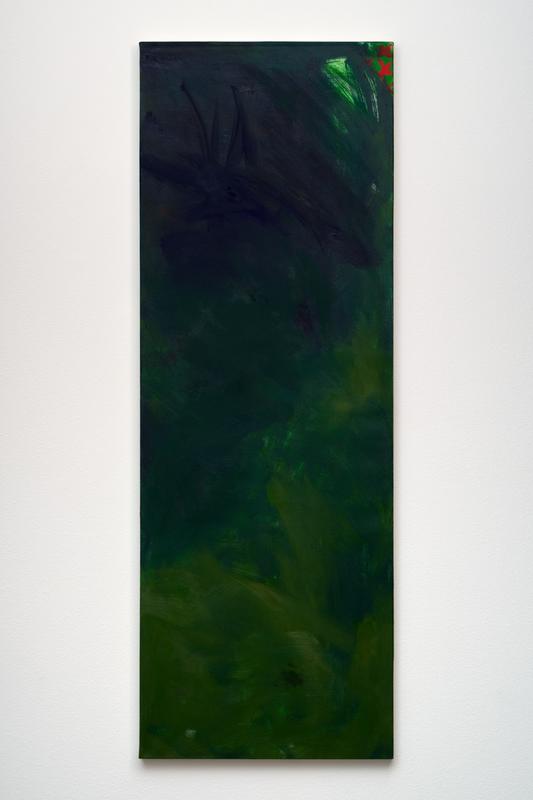
June 1 - July 26, 2024
From late February into early March of 1961, during an unseasonably warm close to a cold English winter, the 29-year-old poet Sylvia Plath (b. 1932) lay in a hospital bed, convalescing from a surgical operation—one that removed her appendix—at St. Pancras Hospital in Central London.
Ten days after her stay at St. Pancras—where her husband, the English poet Ted Hughes, made frequent deliveries of “steak sandwiches & apricot tarts & milk & fresh-squeezed orange juice,” according to letters—Plath wrote Tulips, a poem in nine stanzas.
The poem itself is a psychologically acute portrait of a bedridden subject who willfully modulates a painfully ambivalent return to a state of consciousness through a descriptive appraisal of a given situation.
The works assembled for the second iteration of Tulips at Kapp Kapp, on the fifth anniversary of the inaugural group show, expand the scope of the exhibition’s origins, generationally as well as materially—along thematic lines that pay expressive homage to the vivid sensory imagination of a Sylvia Plath ensconced somewhere in St. Pancras.
Works included in the show, though vastly different in terms of style and medium, likewise figure a set of contextual relationships—whether spatial, temporal, or material—within a given set of constraints, much like Plath does with her own stay at St. Pancras.
Who best to personify a penchant for rearranging the spatial imaginary of America than Queen Martha Stewart herself, the most recent subject of a Sam McKinniss (b. 1985) portrait (and a foil to that other host of the Apprentice, who boasts immunity to any form of legal accountability let alone an electronic ankle bracelet)?
Alicia Adamerovich (b. 1989) returns to part II of Tulips with a distinctively wrought, nearly pointillist handling of surrealist inspired imagery—that spawns figures and forms redolent of an earthy toned yet otherworldly landscape.
Paintings by Julien Ceccaldi (b. 1987) showcase the artist’s mercurial overlay of a Japanese manga aesthetic with gothic tableaux visited by a cast of characters whose props are often plucked from an algorithmically self-referential, twenty-first century landscape.
Louis Osmosis (b. 1996) takes aim at the various aesthetic and cultural currencies that reinforce a contemporary art “status quo,” often devising works that critically intervene in the frequency of their own public reception.
Thomas Blair (b. 1996) has recently turned to contemporary methods of image production such as AI, moreover, distorting their printing process to generate coarse yet simultaneously refined image gradients that subtly challenge our grasp of medium or source material.
While Cynthia Hawkins (b. 1950) continues to draw inspiration from languages of “astrophysics, microbiology, space-time, ancient cave-painted symbols, and mathematics,” what remains consistent to Hawkins’ decades long career is a formal positioning of her work in relation to a range of sensory phenomena. We see an interest in “pure” abstraction in a 1986 painting series where dashes of red paint evoke the “excitable” hue of Plath’s tulips.
Also included in the show are black-and-white photographs by Stanley Stellar (b. 1945) who frames serendipitous encounters to heighten our aesthetic appreciation of a particular historical interplay of subjects and objects in a setting.
Though each is formally distinct down to the minutia of facture, we can place Justin Liam O’Brien (b. 1991) and Anthony Cudahy (b.1989) along a continuum of contemporary artists who have turned to the medium of paint in order to devise complex compositions that figure a queer contemporary sociality along with queer forms of embodiment and isolation.
Though each approaches the construction of pictorial space in altogether different ways, Cudahy and O’Brien often make direct reference to pre-existing situations, settings, or imagery within their compositions, whether of Southern-Italian Renaissance paintings or modish watering holes.
We are left with a group show that lends plastic credence to the persistence of an aesthetic imaginary to rouse consciousness into an awareness of itself—whether we like it or not.
Text by Desiree Mitton.
Tulips will remain on view at Kapp Kapp through July 26, 2024.